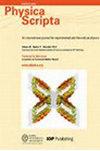The effect of oxidation on tribology behavior of nickel-graphite coated stainless steel SS420
IF 2.6
3区 物理与天体物理
Q2 PHYSICS, MULTIDISCIPLINARY
引用次数: 0
Abstract
The main solution to the challenge of maintaining maximum sealing in the compressor section of each gas turbine is the use of abradable coatings. These coatings have a double duty, including (a) maintaining the lagging and (b) protecting the tips of the rotor blades. Choosing the type of abradable coating primarily depends on the service temperature of the coating. Nickel-graphite (Ni-G) coating is a good choice for use up to 480 °C and, or steel/sub-alloy rotor blades. In this research, the Ni-G coating was applied by the flame spraying method of Ni-G powder with a thickness of about 250 μm on an SS420 stainless steel substrate. The effect of the composition of the bonding layer was also investigated using two compositions, Ni-5Al and NiCrAlY. Obtaining the knowledge of applying Ni-G coating by flame spraying, identifying the structural and compositional characteristics of the coating (through optical and electron metallography), and the effect that oxidation can have on the tribological behavior of the coating were among the goals of this project. The best conditions for spraying the Ni-G coating were achieved an oxygen gas pressure of 6 bar, oxygen flow rate of 18 L min−1, acetylene pressure of 1.5 bar, acetylene flow rate of 24 L min−1, and the distance between the gun head and the sample surface was 22 cm. The results showed that placing the coating in oxidizing conditions increases its coefficient of friction. The increase in the coefficient of friction was attributed to the formation of oxide shells on the surface of the coating after 500 h of exposure to oxidation conditions. Corresponding to the higher coefficient of friction, the oxidized coating showed a decrease in wear resistance as a result of oxidation. This result can show the decrease in abradable of this coating with increasing service time.氧化对镍石墨涂层不锈钢 SS420 摩擦学行为的影响
要在每台燃气轮机的压缩机部分保持最大密封性,主要的解决方案是使用可研磨涂层。这些涂层具有双重作用,包括(a)维护衬垫和(b)保护转子叶片的尖端。选择耐磨涂层的类型主要取决于涂层的使用温度。镍-石墨(Ni-G)涂层是使用温度高达 480 °C 或钢/副合金转子叶片的良好选择。本研究采用火焰喷涂法在 SS420 不锈钢基材上喷涂厚度约为 250 μm 的 Ni-G 涂层。此外,还使用 Ni-5Al 和 NiCrAlY 两种成分研究了结合层成分的影响。本项目的目标包括:了解如何通过火焰喷涂技术应用 Ni-G 涂层、确定涂层的结构和成分特征(通过光学和电子金相分析)以及氧化对涂层摩擦学性能的影响。喷涂 Ni-G 涂层的最佳条件是氧气压力为 6 巴,氧气流量为 18 升/分钟,乙炔压力为 1.5 巴,乙炔流量为 24 升/分钟,喷枪头与样品表面的距离为 22 厘米。结果表明,将涂层置于氧化条件下会增加其摩擦系数。摩擦系数增大的原因是在氧化条件下暴露 500 小时后,涂层表面形成了氧化壳。与摩擦系数升高相对应,氧化涂层的耐磨性也因氧化而降低。这一结果表明,随着使用时间的延长,这种涂层的耐磨性也会下降。
本文章由计算机程序翻译,如有差异,请以英文原文为准。
求助全文
约1分钟内获得全文
求助全文
来源期刊

Physica Scripta
物理-物理:综合
CiteScore
3.70
自引率
3.40%
发文量
782
审稿时长
4.5 months
期刊介绍:
Physica Scripta is an international journal for original research in any branch of experimental and theoretical physics. Articles will be considered in any of the following topics, and interdisciplinary topics involving physics are also welcomed:
-Atomic, molecular and optical physics-
Plasma physics-
Condensed matter physics-
Mathematical physics-
Astrophysics-
High energy physics-
Nuclear physics-
Nonlinear physics.
The journal aims to increase the visibility and accessibility of research to the wider physical sciences community. Articles on topics of broad interest are encouraged and submissions in more specialist fields should endeavour to include reference to the wider context of their research in the introduction.
 求助内容:
求助内容: 应助结果提醒方式:
应助结果提醒方式:


